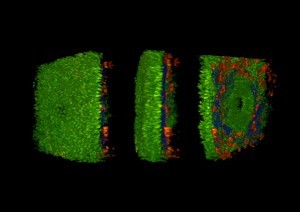New imaging technology can improve colonoscopy diagnostics

FAU researchers developing endoscopes on the basis of multiphoton microscopy
Physicians currently take tiny tissue samples (biopsies) during colonoscopies for histological evaluation. A real-time diagnosis – meaning during the colonoscopy itself – is only possible at a small number of specialised facilities in Erlangen that use confocal endomicroscopy, an innovative technique that necessitates the use of dyes such as fluorescein or acriflavine as contrast agents. Researchers at FAU are now working on a further improvement: using what is known as multiphoton microscopy, it is possible to show and evaluate even very thin tissue layers in 3D and in real time without contrasting agents. The technique has been tested on tissue samples and the results have been promising. Now the researchers are working to develop endoscopes to be used in colonoscopies. This procedure constitutes a potential milestone when it comes to the early recognition of tumours and the diagnosis of inflammatory bowel disease. The researchers recently published their findings in the journal Gastroenterology.*
Multiphoton microscopy is already in use in fundamental research: it allows scientists to see subcellular structures at a resolution of a few micrometres on all three axes, and thus helps them to reconstruct three-dimensional images that would not be possible with any other technology. Prof. Dr. Oliver Friedrich and Dr. Sebastian Schürmann of FAU’s Institute of Medical Biotechnology and Prof. Dr. Markus Neurath and Dr. Maximilian Waldner of Medical Department 1 at Universitätsklinikum Erlangen have now examined whether the technology is applicable in endoscopies, for instance of the intestine. Their first results show that multiphoton microscopy is ideally suited to this purpose.
Structural components in the mucous membrane can be shown in 3D and in three colours – all without using dyes as contrast agents. ‘The attending doctor can make an exact diagnostic assessment in real time, and the patient is spared intravenous administration of a contrast agent,’ says Dr. Maximilian Waldner. Furthermore, quality and safety of diagnoses is improved, for instance when it comes to the early detection of tumours or the assessment of an inflammation in chronic inflammatory bowel diseases such as ulcerative colitis or Crohn’s disease. ‘It is important for successful treatment to be able to tell how deeply the immune cells have penetrated the intestinal tissue, i.e. how far the inflammatory response has progressed. The use of multiphoton microscopy in endoscopies could allow us to assess the degree of inflammation without administering dyes – in real time.’
The scientists have mainly tested the technology on tissue samples. One of the challenges is to miniaturise the technology enough for it to fit into the very small endoscopes that are used nowadays. So far, multiphoton microscopy has only been possible to use on the outside of the body, such as in dermatology. ‘However, the technology has now progressed so far that we consider a time frame of five to ten years for the development of suitable endoscopes realistic,’ says Prof. Dr. Oliver Friedrich. FAU’s advantage here is especially the interdisciplinary research being conducted at the intersection of medical biotechnology and gastroenterology.
* Sebastian Schürmann, Sebastian Foersch, Raja Atreya, Helmut Neumann, Oliver Friedrich, Markus F. Neurath, Maximilian J. Waldner: “Label-Free Imaging of Inflammatory Bowel Disease Using Multiphoton Microscopy”. In: Gastroenterology, Volume 145, Issue 3, September 2013
Further information:
Dr. Maximilian Waldner
Phone: +49 (0)9131 85-45025 or -35960
maximilian.waldner@uk-erlangen.de